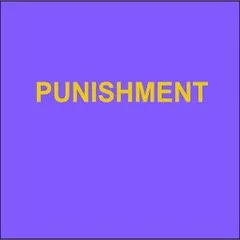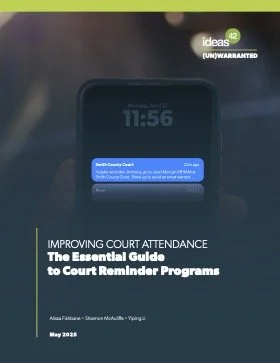IMPROVING COURT ATTENDANCEL The Essential Guide to Court Reminder Programs
By Alissa Fishbane • Shannon McAuliffe • Yiping Li
Introduction Anthony had every intention of appearing for his court date next month. Then, life got complicated. His sister got into a car accident and spent a few days in the ICU. Anthony had to navigate her stay with the insurance company, while also visiting her and arranging for a rehab facility. He fell behind on his work, sleep, laundry, mail. Although a month ago he could never have imagined forgetting his court date, when the time came, he did. Nationwide, millions of people miss their court date—despite their genuine intent to attend. This issue is so widespread that, in areas across the United States, more people are booked into jail for missing court than any other reason. Yet research shows that a primary driver of nonappearance is that people simply forget or struggle to plan properly for their court date—a problem that reminders solve. This report is a complete guide to setting up an effective court reminder program, thereby preventing missed appearances, reducing warrants, and unlocking massive savings—in both resources and dollars—year after year. The high cost of missed appearances Missed court dates create case backlogs, overburden dockets, waste financial and human resources, and lead to jail overcrowding. We conservatively estimate each missed court date costs the government $1,496 in staff time and other resources. This includes rescheduling hearings, issuing warrants, locating individuals, and possible jail time. Yet this figure likely underestimates the true financial impact on courts, attorneys, law enforcement, and jails, not to mention the burdens placed on those with outstanding warrants.i When this figure is multiplied by the millions of missed court dates each year, the expense to taxpayers comes into dramatic focus. Altogether, missed court dates likely cost local government millions of dollars annually—and tens of millions for many state governments. Recognizing this hefty price tag, courts are increasingly turning to reminders as a cost-effective, proactive solution, rather than relying solely on costly, reactive punitive measures like warrants. It’s a classic case of “an ounce of prevention is worth a pound of cure.” Why reminders work We are all human, and missing appointments happens to everyone. In fact, doctor appointments are missed at rates similar to, or even higher than, court dates. This is why reminders are accepted and widely used by businesses and governments—and increasingly by courts: they help bridge the gap between intention and action, and they work. They’re practical, effective, and inexpensive. Reminders work because they address the widespread, yet often overlooked, behavioral reasons people miss court. Sometimes people miss court for logistical reasons (no transportation, inflexible work schedules, childcare duties), but many miss for reasons related to poverty and its effect on mental bandwidth, simple forgetfulness when life gets overwhelming, and "present bias"—where people focus more on the immediate costs of attending court (like fear or missing work) than the larger, long-term consequences of missing court, such as warrants and arrest. Court reminders address these issues by helping people remember their court date, understand the consequences of missing court, proactively plan to attend, and reduce their fear or confusion. Moreover, the effectiveness of reminders is well-established and backed by extensive research. Rigorous evaluations consistently show that court reminders reduce nonappearance by 20 to 40%. Studies show they are even more effective for people who have previously missed court. A small initial investment in a reminder system, with minimal per-reminder costs thereafter, will significantly improve appearance rates. This, in turn, will lead to massive savings for governments and taxpayers, while also reducing the negative consequences for individuals who would otherwise miss court. About this guide We designed this resource for those seeking to use proven, cost-effective practices to create or improve a court reminder system, including court administrators, policymakers, IT teams, clerks, judges, legislators, public defenders, district attorneys, pretrial agencies, and others. The goal is to provide a clear roadmap for system stakeholders to understand and implement this low-cost, high-impact solution to increase court appearance rates and improve overall court efficiency. While we focus on the criminal court system (most studies are based on offenses with warrant consequences— felony, misdemeanor, and some traffic cases), the principles outlined here can also be applied in civil or family courts, helping courts achieve better outcomes in all case types. This guide is grounded in evidence, operational best practices, and the science of human behavior. It breaks down the fundamentals of building a successful reminder program into achievable steps and demystifies the process. We’ll show you proven strategies for content and timing, system options for creating and sending reminders, and technology platforms and their basic costs. Plus, we’ll explore crucial elements like collecting contact information and the importance of auto-enrollment for broad and impactful reach. By reading this report, you'll discover how simple changes can dramatically enhance the quality, efficiency, and impact of court operations in your jurisdiction. With these tools at your disposal, you can start boosting court appearances—benefiting the court, its partners and stakeholders, the people attending, and their communities.
New York: Ideas 42: 2025. 59p.


